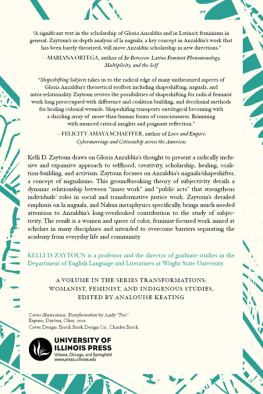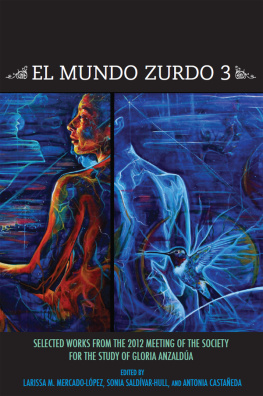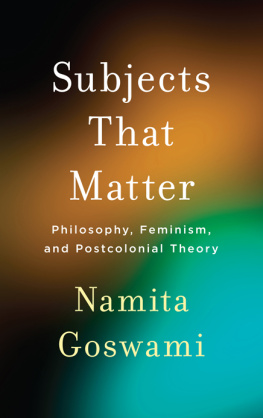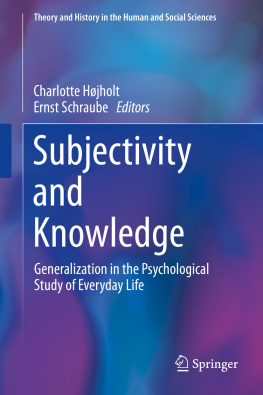TRANSFORMATIONS: WOMANIST, FEMINIST, AND INDIGENOUS STUDIES
Edited by AnaLouise Keating
A list of books in the series appears at the end of this book.
Shapeshifting Subjects
Gloria Anzalda's Naguala and Border Arte
KELLI D. ZAYTOUN

2022 by the Board of Trustees of the University of Illinois
All rights reserved
Cataloging data available from the Library of Congress
ISBN 9780252044434 (hardcover)
ISBN 9780252086519 (paperback)
ISBN 9780252053436 (ebook)
todos juntos
lucirnagas de la noche soando el cosmos
we all together
fireflies in the night dreaming up the cosmos
nehhuantin tocepan
tixoxotlameh yohuatzinco tictemiquih in cemanahuactli
Francisco X. Alarcn
Flor y canto / Flower and Song / In xochitl in cuicatl
Series Editor's Foreword
ANALOUISE KEATING
What does transformation look like? What's the relationship among language, reading, writing, and progressive social-justice work? How can we use words, ideas, theories, and stories to develop inclusive, life-affirming communities? How can we enact transformation in our daily practices and other areas of our lives? The series Transformations: Womanist, Feminist, and Indigenous Studies has its origins in these and related questions. Grounded in the belief that radical, progressive changeon individual, collective, national, transnational, and planetary levelsis urgently needed and, in fact, possible (although typically not easy to achieve), this book series exists to offer new venues for transdisciplinary scholarship informed by women-of-colors theories and post-oppositional approaches to knowledge production and social change. The series Transformations invites authors to take risks (thematically, theoretically, methodologically, and/or stylistically) in their workto build on while moving beyond disciplinary- or interdisciplinary-specific academic rules, and through these risks to invent new (transdisciplinary) perspectives, methods, and knowledge.
Books in this series foreground women-of-colors theorizing because these theories offer innovative, though too often overlooked, perspectives on transformation. Women-of-colors theories give us the intellectual grounding and visionary yet pragmatic tools to understand, challenge, and alter the existing frameworks and paradigms that structure (and constrain) our lives. These tools are riskier, more innovative and imaginativerich with the potential to transform. Take, for example, post-oppositionality as an alternative approach to social-justice work (including progressive academic scholarship). Post-oppositionality invites us to think differently, to step beyond our conventional rules, and to learn from, build on, and liberate ourselves from the oppositionally based theories and practices we generally employ. I describe these alternatives as post-oppositional to underscore both their relationship to oppositional thought and their visionary invitation to move (at least) partially through it. Post-oppositionality enacts relational approaches to knowledge production, identity formation, and social change that borrow from but don't become trapped within oppositional thought and action. Post-oppositionality neither completely rejects nor entirely moves beyond oppositionality but, instead, enacts a complex dance with it, creating new perspectives as it does so. Although post-oppositionality can take many forms, these forms typically share several traits: belief in people's interconnectedness with all that exists, acceptance of paradox and contradiction, and the desire to be radically inclusiveto seek and create complex commonalities and broad-based alliances for social change.
Kelli D. Zaytoun's Shapeshifting Subjects: Gloria Anzalda's Naguala and Border Arte brilliantly illustrates these post-oppositional traits and others, as well. Indeed, the entire book is grounded in a radically relational approach. Look, for instance, at her insightful analysis of Anzalda's complicated relationship to Indigeneity. Zaytoun thoughtfully sorts through the various scholarly critiques; looks carefully at Anzalda's research, experience, and discussions on the topic; and offers a remarkable, powerful interpretation. She models a post-oppositional approach to scholarship that we can learn from and enact in our own work, thus fulfilling her aspiration to create a theoretical project with practical aims. (I love this connection between theory and practicality, this reminder that theorizing can be profoundly practical.) I attribute Zaytoun's skillful post-oppositionality, at least in part, to her deep understanding of relationality and relational selfhood.
Zaytoun's profound understanding of relationality is evident throughout the book: in the connections she draws between Anzalda and Arab American women's writing; in her innovative approach to Anzalda's theories of la naguala and border arte; in her analysis and engagement with Nahua metaphysics, new materialist theory, and posthumanist thought; and in her interpretation of la naguala as a practice of consciousnessto mention only a few of the most striking examples.
Shapeshifting Subjects embodies the book series aspirations in other ways, as well. Guided by some of Anzalda's most innovative, provocative work, Shapeshifting Subjects is transdisciplinary, boldly inclusive, risky, and accessible to read. I want to linger over this last item. (Well, if space allowed I would linger over all of the points packed into that sentence.) All too often, we confuse elite language with intellectual prowess and elevated thought, but by so doing we restrict ourselves to a narrow, exclusive audience. Zaytoun does not take this route to knowledge creation. She works carefully and intentionally to communicate effectively with a wide audience, aspiring to dissolve disciplinary boundaries and the barriers between the academy and everyday life and community. With this aspiration and intentionality, Zaytoun (like Anzalda herself) bridges academic fields and contemporary worlds, offering new perspectives with important implications for us all.
Preface
I could imagine her feeling her wings growing wide, her feathers soft and glimmering, her ears little feather tufts, eyes golden yellow, she's perched high in a tree. The sky behind her is indigo. She is able to see far into the distant night. She listens to the gentle breezes against her face.
Gloria Anzalda
As a child I had a vivid, recurring dream in which I could fly at night. In that threshold between wakefulness and sleep, I would leave my body and float to the ceiling and drift around the house. Someone or something seemed to be keeping me afloat, and weightless and wide-eyed, I would glide, sometimes swoosh around from room to room. In my dreams and imagination at that early age, my experience of the world was much more vast and intimate than it is today. With vigor I stretched my arms to feel the sky; pumped my bike pedals till I soared; touched and talked to plants, bugs, and birds; and all the while felt either carried by, or one with, something with wings. As I grew older, I lost touch with those dreams and forms of play, but I remember the sensation to this day, a sensation that I, in the process of writing about the naguala, have come to identify as a shamanic journey, my participation in an experience and a realm beyond the concrete, yet so visceral that it serves as my first memory. When I first wrote about the dream, I had conjured the memory as I was reflecting on how I connected, in terms of border identities, with Gloria Anzalda. At the time I linked the unexpected image to a passage in









